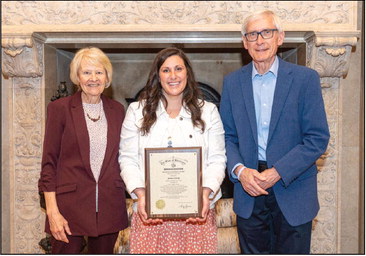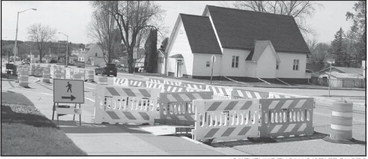Greenwood, Loyal boards establish July 2028 as goal date to consolidate
By Valorie Brecht The Loyal and Greenwood school boards have honed in on July 2028 as the target date for the districts to start operating as one consolidated district. On Monday night, the Greenwood and Loyal school boards held their first joint meeting since the April 1 election. The main purpose of the meeting was to review the election results and discuss the consolidation process and timeline.
At the meeting held in the Loyal High School gym, Loyal District Administrator Chris Lindner and Greenwood District Administrator Joe Green presented a hypothetical consolidation timeline they had received from Baird Financials, a consulting company that completed the financial feasibility study for the districts.
A consolidated district must begin July 1 because that is the start of a school district’s fiscal year. After both boards pass a resolution to consolidate, statutorily they must follow a 12-month, 14-month, or 18-month timeline before they begin operating as a unified district. The 18-month timeline is the one Greenwood and Loyal have focused on and what has been publicized. That would involve both school boards passing a resolution to consolidate in December 2026. Residents would have until February 2027 to file a petition for referendum if they wanted the question to go back to the voters. If 10% of the electorate filed a petition, the referendum would be required and would take place in April 2027.Assuming it passed, the school districts would go on to consolidate in July 2028, and the 2028-29 school year would be the first year as a consolidated district.
Both boards were satisfied with the proposed plan. The only caveat is that Lindner and Green plan to meet with Bob Butler, associate executive director and staff counsel for the Wisconsin Association of
Please see Consolidation, page 10 Consolidation,
from p. 1
School Boards (WASB), on Thursday, to clarify a few legalities about a resolution to consolidate and make sure they are in line with state statute. They also want to find out what services WASB can offer to ease the transition.
Loyal board member Kirk Haslow said he would like to see the districts consolidate one year earlier, so the taxpayers could experience the cost savings from consolidation sooner. The Baird study estimated the districts could save about $1 million by consolidating, the savings coming from areas like eliminating duplicative administrative and staffing positions, contracted services, licensing and software, and co-curricular activities.
“I think we should do it (consolidation) sooner; we can save each district about $500,000,” said Haslow.
“If that’s the course both boards choose, we could do that. However, we would not capture the final year of operational referendum dollars,” said Green.
Both districts are currently under operational referendums that have the 2027-28 school year as their final year. Loyal’s referendum will be for $1.5 million that year and Greenwood’s will be $1.725 million. As a consolidated district, they will still need to go for referendum; however, the districts anticipate it would be a lesser ask because of the expected cost savings. If the 2028-29 school year is the first year as a consolidated district, the operational referendum would be put on the ballot in November 2028.
Haslow was still in favor of passing a resolution to consolidate sooner rather than later, so that a new combined joint board would be the entity making the decisions. The joint board would have to be reconfigured, as there are currently five members on Greenwood’s board and seven members on Loyal’s board and there would need to be equal representation. Haslow alluded to if a couple of Loyal members willingly stepped down, that would make it five and five on the new board.
“I want to get poppin’ on this as soon as possible. If we passed a resolution in December of this year, we could have elections for the new school board already,” he said.
He also asked if the boards were to pass a resolution to consolidate in December of this year, did that automatically start the 18-month clock to consolidation or could the boards decide when they wanted consolidation to take effect? Lindner and Green said they were not sure and would have to check with Butler.
Although Haslow was ready to move forward with a consolidation vote, several other board members were inclined to wait before doing the official vote. New Loyal board member Crystal Rueth said she knew several people who had voted yes on the ballot question simply because they wanted the boards to look at the issue and come up with a plan, while conversely a lot of people said not because they felt they didn’t have enough information. She said the boards owed it to the public to provide more information.
Loyal board member Tom Odeen felt the boards should look at consolidation in four phases: 1. Gather information, 2. Analyze the information, 3. Decision making, and 4. Implementation.
“My concern is we allow enough time to do each phase. We only have one opportunity to do this well,” said Odeen. “We need to trust the process. It’s also important to have all stakeholders informed and involved.”
He also reiterated what he had said at the Loyal board meeting the week before. “We don’t have some grand plan on what we’re going to do next; we don’t have a hidden agenda (such as where the high school and elementary school will be). We need to look at the data and let that drive our decisions…Wewanttomake sure we are gathering information and not getting out ahead of ourselves.” Several board members from Loyal and Greenwood said they liked Odeen’s framework and felt it would be useful moving forward.
Odeen suggested an immediate next step would be for Butler or other representatives from WASB to attend an open meeting of both boards, to review the timelines and answer any questions the boards may have. Lindner and Green planned to ask Butler if he would be available for something like that and get back to the boards. Future joint board meeting agendas will be posted in the TRG and on each school district’s website. Loyal meetings are also livestreamed on the district’s YouTube channel.
Another potential next step could be a facilities study. Loyal board member Derek Weyer said he would like to see a non-biased third party conduct a facilities study to determine the best number of schools and location of schools.
“Some of the emotion needs to be taken out of it,” he said.
The boards talked about doing a facilities study last spring, but voted to do the feasibility study first. Nothing has been voted on yet in regards to a facilities study.
Other main takeaways from the meeting were continuing to keep the community informed and involved, and continuing to develop a collective “us” mentality rather than Loyal and Greenwood as separate entities. Greenwood board member Dean Lindner said he wanted to make sure all stakeholders were being involved.
“When we’re looking at having discussions about class offerings, the staff and the principals are the ones that need to be involved in those discussions. If it’s a club like FFA, the advisors from both schools need to meet and then come back to us and give us ideas,” he said. “And we need to focus on doing what’s best for all of our kids.”
Eliza Ruzic, also on the Greenwood board, agreed and felt that it was time to move forward and not second-guess what the community had told them in the vote, with 66% of Loyal voters and 78% of Greenwood voters expressing support for consolidation.
“Going off the advisory referendum question, before the vote, I sat in an open forum meeting and said, ‘If you care where the high school building is going to be, vote no.’ So I was pretty clear. I don’t want to spend money on another ballot question if we can avoid it. I think we need to move forward in all areas, whether it’s curriculum, staffing, clubs… We need to think with a collective ‘us’ mentality instead of an ‘us versus them.’ Most districts have had that tunnel vision for years and years. We do need to open up it to other districts too.”
Lindner pointed out that, to both districts’ credit, they had at least been willing to sit down and have plenty of conversations over the past couple of years in efforts get the best opportunities in front of students.
“I hear a lot of people say, ‘Well, why is no one else looking at consolidation?’ I think a lot of communities are thinking about consolidation, but here’s the step right here they can’t get at,” he said, gesturing to the board members seated around the table. “They can’t get their boards together. So kudos to you guys on getting this done and continuing the process. And the second thing is, I think we have a lot of eyes on us to see what’s going to happen here and that will piggyback as far as whatever happens to their district.”



